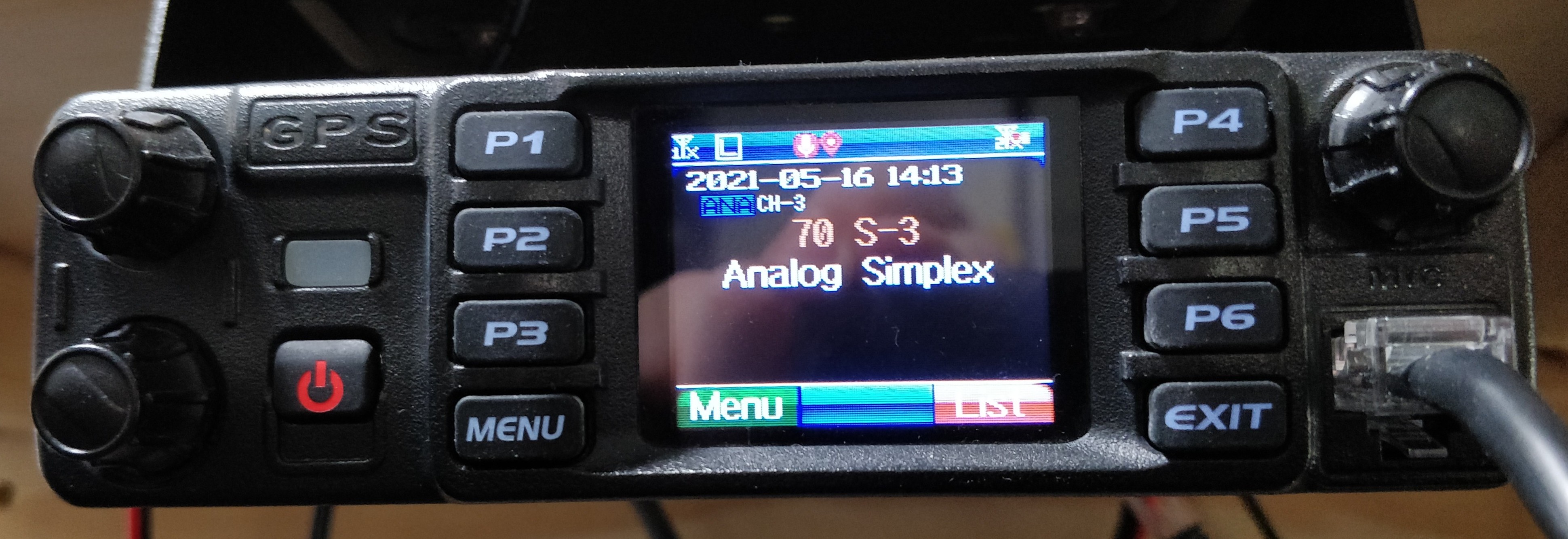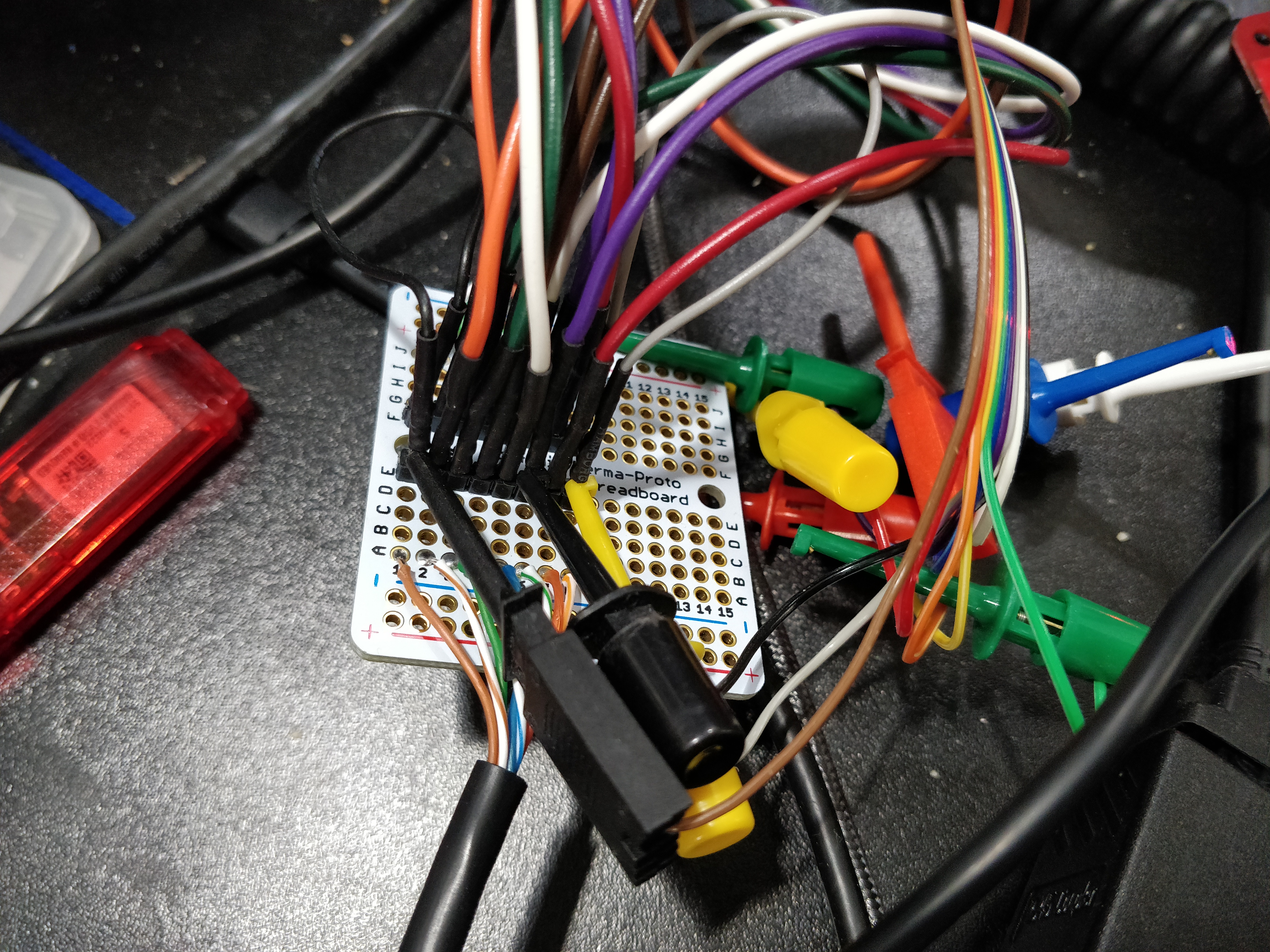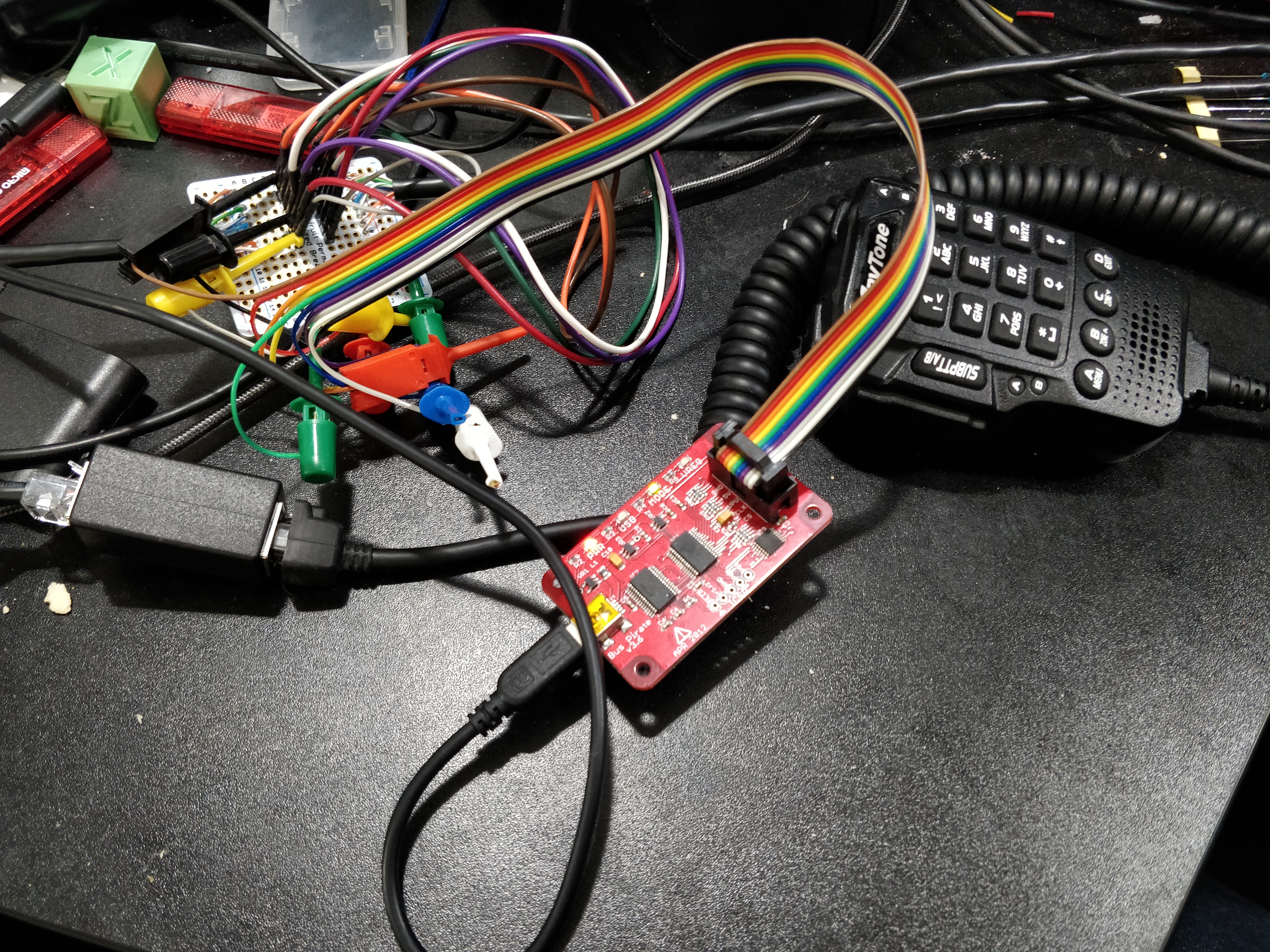This is a python library designed to interface to an AnyTone™ AT-D578UV radio's Microphone port serial connection.
- Control the radio's PTT line
- Send keypad button presses
- Continuously monitor the radio's state
- Perform callbacks on RX sense
Copyright © 2021 Michael Englehorn
This program is free software: you can redistribute it and/or modify it under the terms of the GNU General Public License as published by the Free Software Foundation, either version 3 of the License, or (at your option) any later version.
This program is distributed in the hope that it will be useful, but WITHOUT ANY WARRANTY; without even the implied warranty of MERCHANTABILITY or FITNESS FOR A PARTICULAR PURPOSE. See the GNU General Public License for more details.
You should have received a copy of the GNU General Public License along with this program. If not, see https://www.gnu.org/licenses/.
pip install d578uv-k0hax
from d578uv import d578uv
radio = d578uv.d578uv('/dev/ttyUSB0')
# Transmit for 5 seconds
radio.Tx(5)
# Transmit until told to stop transmitting
radio.Tx()
# Stop transmitting, enter receive mode
radio.Rx()
In order to determine which UART commands needed to be sent to the radio, and how the radio responds, I used a Bus Pirate by Dangerous Prototypes
I also built a small Cat5 cable breakout that split the cable between the radio and microphone, and allowed me to probe it while it was in operation.
Notes
- A single 0x06 packet is sent approximately once per second by the microphone to the radio as a type of keepalive
| Description | Byte 0 | PTT | Pressed | Long Press | Button Address | Byte 5 | Byte 6 | Number of Bytes |
|---|---|---|---|---|---|---|---|---|
| PTT Pressed | 0x41 | 0x01 | 0x00 | 0x00 | 0x00 | 0x00 | 0x00 | 7 |
| PTT Released | 0x41 | 0x00 | 0x00 | 0x00 | 0x00 | 0x00 | 0x00 | 7 |
| A = Pressed | 0x41 | 0x00 | 0x01 | 0x00 | 0x1a | 0x00 | 0x00 | 7 |
| A = Held Long | 0x41 | 0x00 | 0x01 | 0x01 | 0x1a | 0x00 | 0x00 | 7 |
| A = Released | 0x41 | 0x00 | 0x00 | 0x01 | 0x1a | 0x00 | 0x00 | 7 |
| B = Pressed | 0x41 | 0x00 | 0x01 | 0x00 | 0x1b | 0x00 | 0x00 | 7 |
| B = Held Long | 0x41 | 0x00 | 0x01 | 0x01 | 0x1b | 0x00 | 0x00 | 7 |
| B = Released | 0x41 | 0x00 | 0x00 | 0x01 | 0x1b | 0x00 | 0x00 | 7 |
| C = Pressed | 0x41 | 0x00 | 0x01 | 0x00 | 0x1c | 0x00 | 0x00 | 7 |
| C = Held Long | 0x41 | 0x00 | 0x01 | 0x01 | 0x1c | 0x00 | 0x00 | 7 |
| C = Released | 0x41 | 0x00 | 0x00 | 0x01 | 0x1c | 0x00 | 0x00 | 7 |
| D = Pressed | 0x41 | 0x00 | 0x01 | 0x00 | 0x1d | 0x00 | 0x00 | 7 |
| D = Held Long | 0x41 | 0x00 | 0x01 | 0x01 | 0x1d | 0x00 | 0x00 | 7 |
| D = Released | 0x41 | 0x00 | 0x00 | 0x01 | 0x1d | 0x00 | 0x00 | 7 |
| D = Short 1 | 0x41 | 0x00 | 0x01 | 0x00 | 0x1d | 0x00 | 0x00 | 7 |
| D = Short 2 | 0x41 | 0x00 | 0x00 | 0x00 | 0x1d | 0x00 | 0x00 | 7 |
| 1 = Pressed | 0x41 | 0x00 | 0x01 | 0x00 | 0x02 | 0x00 | 0x00 | 7 |
| 2 = Pressed | 0x41 | 0x00 | 0x01 | 0x00 | 0x03 | 0x00 | 0x00 | 7 |
| 3 = Pressed | 0x41 | 0x00 | 0x01 | 0x00 | 0x04 | 0x00 | 0x00 | 7 |
| 4 = Pressed | 0x41 | 0x00 | 0x01 | 0x00 | 0x05 | 0x00 | 0x00 | 7 |
| 5 = Pressed | 0x41 | 0x00 | 0x01 | 0x00 | 0x06 | 0x00 | 0x00 | 7 |
| 6 = Pressed | 0x41 | 0x00 | 0x01 | 0x00 | 0x07 | 0x00 | 0x00 | 7 |
| 7 = Pressed | 0x41 | 0x00 | 0x01 | 0x00 | 0x08 | 0x00 | 0x00 | 7 |
| 8 = Pressed | 0x41 | 0x00 | 0x01 | 0x00 | 0x09 | 0x00 | 0x00 | 7 |
| 9 = Pressed | 0x41 | 0x00 | 0x01 | 0x00 | 0x0a | 0x00 | 0x00 | 7 |
| 0 = Pressed | 0x41 | 0x00 | 0x01 | 0x00 | 0x01 | 0x00 | 0x00 | 7 |
| * = Pressed | 0x41 | 0x00 | 0x01 | 0x00 | 0x0b | 0x00 | 0x00 | 7 |
| # = Pressed | 0x41 | 0x00 | 0x01 | 0x00 | 0x0c | 0x00 | 0x00 | 7 |
| SubPTT = Pressed | 0x41 | 0x00 | 0x01 | 0x00 | 0x0d | 0x00 | 0x00 | 7 |
| Down = Pressed | 0x41 | 0x00 | 0x01 | 0x00 | 0x11 | 0x00 | 0x00 | 7 |
| Up = Pressed | 0x41 | 0x00 | 0x01 | 0x00 | 0x10 | 0x00 | 0x00 | 7 |
This is for clarity
| Button | Address |
|---|---|
PTT |
0x00 |
0 |
0x01 |
1 |
0x02 |
2 |
0x03 |
3 |
0x04 |
4 |
0x05 |
5 |
0x06 |
6 |
0x07 |
7 |
0x08 |
8 |
0x09 |
9 |
0x0a |
* |
0x0b |
# |
0x0c |
SubPTT |
0x0d |
Up |
0x10 |
Down |
0x11 |
A |
0x1a |
B |
0x1b |
C |
0x1c |
D |
0x1d |
| Description | Byte 0 | Byte 1 | Byte 2 | Byte 3 | Byte 4 | Byte 5 | Byte 6 | Byte 7 | Byte 8 | Byte 9 | Byte 10 | Byte 11 | Byte 12 | Byte 13 | Byte 14 | Byte 15 |
|---|---|---|---|---|---|---|---|---|---|---|---|---|---|---|---|---|
| RX Start, A | 0x53 | 0x01 | 0x01 | 0x00 | 0x00 | 0x00 | 0x00 | 0x00 | 0x00 | 0x10 | 0x00 | 0x00 | 0x00 | 0x00 | 0x00 | 0x06 |
| RX Stop, A | 0x53 | 0x00 | 0x00 | 0x00 | 0x00 | 0x00 | 0x00 | 0x00 | 0x00 | 0x10 | 0x00 | 0x00 | 0x00 | 0x00 | 0x00 | 0x06 |
| A to B | 0x53 | 0x00 | 0x00 | 0x00 | 0x00 | 0x00 | 0x00 | 0x01 | 0x00 | 0x10 | 0x00 | 0x00 | 0x00 | 0x00 | 0x00 | 0x06 |
| B to A | 0x53 | 0x00 | 0x00 | 0x00 | 0x00 | 0x00 | 0x00 | 0x00 | 0x00 | 0x10 | 0x00 | 0x00 | 0x00 | 0x00 | 0x00 | 0x06 |
| CMD Ack | 0xaa | |||||||||||||||
| TX Start, A | 0x53 | 0x00 | 0x00 | 0x01 | 0x00 | 0x00 | 0x00 | 0x00 | 0x00 | 0x10 | 0x00 | 0x00 | 0x00 | 0x00 | 0x00 | 0x06 |
| TX Start, B | 0x53 | 0x00 | 0x00 | 0x00 | 0x00 | 0x00 | 0x01 | 0x01 | 0x00 | 0x10 | 0x00 | 0x00 | 0x00 | 0x00 | 0x00 | 0x06 |
| TX End, A | 0x53 | 0x00 | 0x00 | 0x00 | 0x00 | 0x00 | 0x00 | 0x00 | 0x00 | 0x10 | 0x00 | 0x00 | 0x00 | 0x00 | 0x00 | 0x06 |
| TX End, B | 0x53 | 0x00 | 0x00 | 0x00 | 0x00 | 0x00 | 0x00 | 0x01 | 0x00 | 0x10 | 0x00 | 0x00 | 0x00 | 0x00 | 0x00 | 0x06 |


